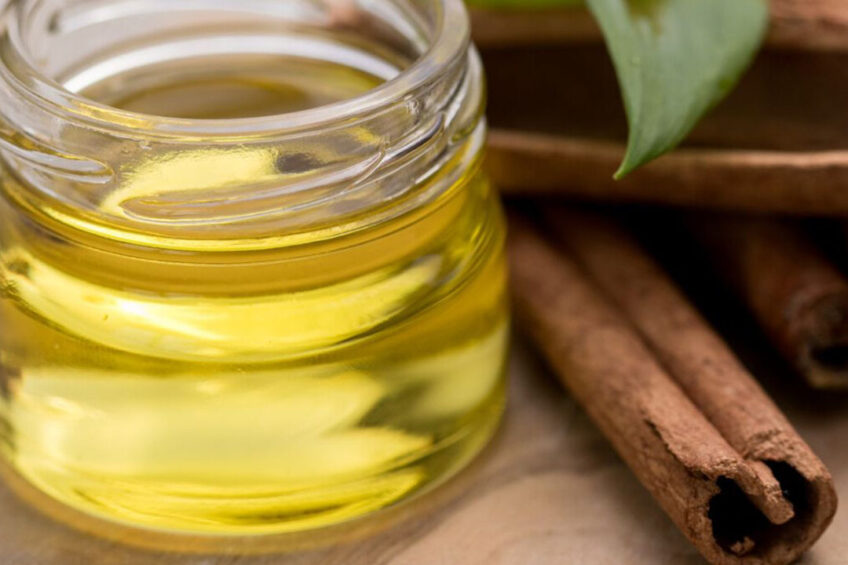6 essential oils for the treatment for mastitis

Bovine mastitis is an inflammation of the mammary gland due to physical trauma or pathogenic organisms. Novel antibiotic alternatives are required, such as plant extracts or essential oils that exhibit antibacterial activity against both resistance-acquired and non-resistance pathogens.
Bovine mastitis results in altered milk quality, increased labour and treatment costs, premature culling of cows, and global annual losses of approximately US$35 billion. Antibiotics have been administered as the primary approach for mastitis treatment; however, their efficacy is limited and results in antibiotic-resistant strains of pathogens.
A number of antibiotic alternatives, such as plant extracts or essential oils, exhibit antibacterial activity.
 Cinnamon
Cinnamon
Cinnamon is obtained from the inner bark of various trees belonging to the genus Cinnamomum. Cinnamon essential oils have antibacterial effects due to secondary metabolites such as trans-cinnamaldehyde, cinnamyl acetate, eugenol, L-borneol, camphor, caryophyllene oxide, β-caryophyllene, and L-bornyl acetate.
Essential oils from Cinnamomum aromaticum, Cinnamomum cassia, and Cinnamomum zeylanicum show antibacterial impacts against Staphylococcus species associated with mastitis. In addition, cinnamon oil is more effective against Gram-positive than Gram-negative bacteria due to the outer membrane of Gram-negative bacteria acting as an impermeable barrier, thus preventing cinnamon oil from penetrating into cells.
A combination of cinnamon oil and silver nanoparticles causes a 100% inhibition of Staphylococcus agalactiae cells within 4 hours. Cinnamomum cassia oil ruptures Staphylococcus aureus and E. coli membranes, reduces biofilm formation, and provides an additional layer of protection against mastitis. Furthermore, cinnamon alleviates both inflammation and damage of the mammary tissue associated with mastitis.
 Origanum
Origanum
Origanum essential oils comprise of terpenes, phenols, phenolic acids, flavonoids, carvacrol, thymol, linalool, and sabinene hydrate. Carvacrol is a phenolic monoterpenoid that causes structural and functional damage to microbial cell membranes such as Staphylococcus aureus and E. coli, thus resulting in increased fluidity and permeability.
Origanum vulgare, popularly called ‘oregano’ in most European countries and the US, is effective against predominant mastitis pathogens including E. coli, Cronobacter sakazakii, Klebsiella oxytoca, Staphylococcus aureus, Streptococcus dysgalactiae, and Streptococcus uberis, Serratia marcescens, Proteus mirabilis, and Prototheca zopfii. Origanum majorana significantly reduces the bacterial population of Staphylococcus aureus, Streptococcus agalactiae, and E. coli.
 Thymus
Thymus
The main components of thymus essential oils include thymol, p-cymene, and γ-terpinene. Thymol belongs to the phenolic monoterpenoid with antimicrobial activity resulting in structural and functional changes of the cytoplasmic membrane affecting permeability. Thymus species have been successfully tested against both contagious and environmental mastitis causing bacteria.
Thymus vulgaris L. (common thyme) essential oil demonstrates a strong antibacterial potential against Streptococcus β-hemolytic, Enterobacter sakazakii, E. coli, and Klebsiella oxytoca. Thymus serpyllum L. (wild thyme) essential oil shows a strong antibacterial activity against coagulase-negative Staphylococci. Thymus fontanesii essential oil exerts a high antibacterial activity against E. coli and Staphylococcus aureus.
 Melaleuca
Melaleuca
The Melaleuca essential oil is known as tea tree oil which contains more than 100 components including various monoterpenes, sesquiterpenes, and aromatic compounds. Tea tree oil exerts antibacterial action against E. coli and Staphylococcus aureus, thus destabilising potassium ion gradients, inhibiting respiration, and promoting membrane leakiness.
Tea tree oil also shows bactericidal activity against Staphylococcus species, Streptococcus species, Klebsiella pneumoniae, and Candida albicans and provides effective protection to the body by decreasing the proliferation of inflammatory cells without affecting their ability to secrete anti-inflammatory cytokines. Melaleuca armillaris essential oil has synergic effect with rifaximin and erythromycin against Staphylococcus aureus.
 Lavandula
Lavandula
The main components of Lavandula essential oils are linalool, linalyl acetate, terpenes, and non-terpenoid aliphatic components. Lavandula angustifolia shows efficiency against pathogenic isolates such as Staphylococcus species, Bacillus cereus, and Kytococcus sedentarius. Lavandula stoechas reduces the bacterial population of Staphylococcus aureus, Streptococcus agalactiae, and E. coli.
 Minthostachys verticillata
Minthostachys verticillata
The chemical composition of Minthostachys verticillate essential oil includes monoterpenes pulegone, menthone, isomenthone, limonene, menthol, and α-pinene. Limonene inhibits the growth of Streptococcus uberis, E. coli, Bacillus pumilus, and Enterococcus faecium.
Conclusion
Mastitis is a major disease in the dairy industry that leads to reduced milk yield, poor milk quality, and economic losses. Plant-derived essential oils and some of their components, including thymol, carvacrol, limonene, p-cymene, cinnamaldehyde, and phenyl-methyl ethers cross the cell membrane of bacteria, destabilise cellular architecture, cause disruption of membrane integrity, and increase permeability. They are, therefore, effective against a range of mastitis-causing pathogens.
Join 13,000+ subscribers
Subscribe to our newsletter to stay updated about all the need-to-know content in the dairy sector, two times a week.










